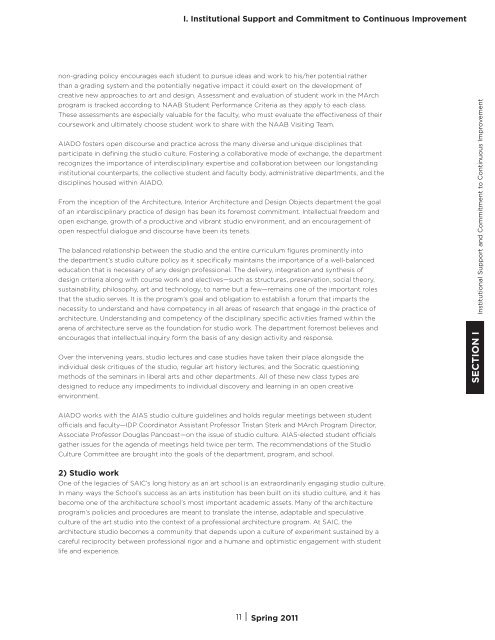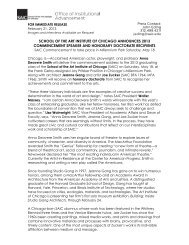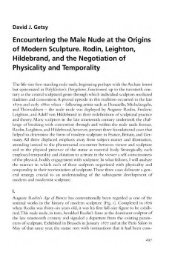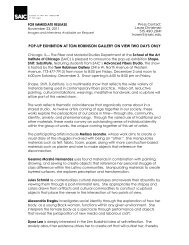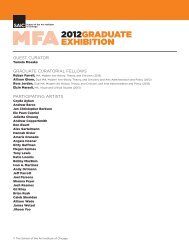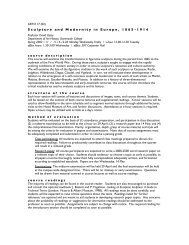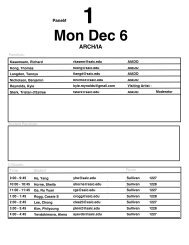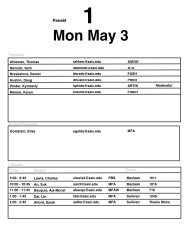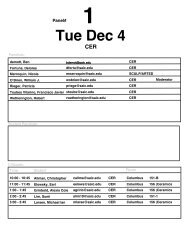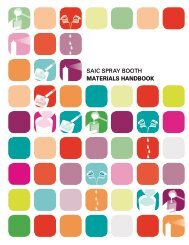i. institutional support and commitment to continuous improvement
i. institutional support and commitment to continuous improvement
i. institutional support and commitment to continuous improvement
You also want an ePaper? Increase the reach of your titles
YUMPU automatically turns print PDFs into web optimized ePapers that Google loves.
I. Institutional Support <strong>and</strong> Commitment <strong>to</strong> Continuous Improvement<br />
non-grading policy encourages each student <strong>to</strong> pursue ideas <strong>and</strong> work <strong>to</strong> his/her potential rather<br />
than a grading system <strong>and</strong> the potentially negative impact it could exert on the development of<br />
creative new approaches <strong>to</strong> art <strong>and</strong> design. Assessment <strong>and</strong> evaluation of student work in the MArch<br />
program is tracked according <strong>to</strong> NAAB Student Performance Criteria as they apply <strong>to</strong> each class.<br />
These assessments are especially valuable for the faculty, who must evaluate the effectiveness of their<br />
coursework <strong>and</strong> ultimately choose student work <strong>to</strong> share with the NAAB Visiting Team.<br />
AIADO fosters open discourse <strong>and</strong> practice across the many diverse <strong>and</strong> unique disciplines that<br />
participate in defining the studio culture. Fostering a collaborative mode of exchange, the department<br />
recognizes the importance of interdisciplinary expertise <strong>and</strong> collaboration between our longst<strong>and</strong>ing<br />
<strong>institutional</strong> counterparts, the collective student <strong>and</strong> faculty body, administrative departments, <strong>and</strong> the<br />
disciplines housed within AIADO.<br />
From the inception of the Architecture, Interior Architecture <strong>and</strong> Design Objects department the goal<br />
of an interdisciplinary practice of design has been its foremost <strong>commitment</strong>. Intellectual freedom <strong>and</strong><br />
open exchange, growth of a productive <strong>and</strong> vibrant studio environment, <strong>and</strong> an encouragement of<br />
open respectful dialogue <strong>and</strong> discourse have been its tenets.<br />
The balanced relationship between the studio <strong>and</strong> the entire curriculum figures prominently in<strong>to</strong><br />
the department’s studio culture policy as it specifically maintains the importance of a well-balanced<br />
education that is necessary of any design professional. The delivery, integration <strong>and</strong> synthesis of<br />
design criteria along with course work <strong>and</strong> electives—such as structures, preservation, social theory,<br />
sustainability, philosophy, art <strong>and</strong> technology, <strong>to</strong> name but a few—remains one of the important roles<br />
that the studio serves. It is the program’s goal <strong>and</strong> obligation <strong>to</strong> establish a forum that imparts the<br />
necessity <strong>to</strong> underst<strong>and</strong> <strong>and</strong> have competency in all areas of research that engage in the practice of<br />
architecture. Underst<strong>and</strong>ing <strong>and</strong> competency of the disciplinary specific activities framed within the<br />
arena of architecture serve as the foundation for studio work. The department foremost believes <strong>and</strong><br />
encourages that intellectual inquiry form the basis of any design activity <strong>and</strong> response.<br />
Over the intervening years, studio lectures <strong>and</strong> case studies have taken their place alongside the<br />
individual desk critiques of the studio, regular art his<strong>to</strong>ry lectures, <strong>and</strong> the Socratic questioning<br />
methods of the seminars in liberal arts <strong>and</strong> other departments. All of these new class types are<br />
designed <strong>to</strong> reduce any impediments <strong>to</strong> individual discovery <strong>and</strong> learning in an open creative<br />
environment.<br />
AIADO works with the AIAS studio culture guidelines <strong>and</strong> holds regular meetings between student<br />
officials <strong>and</strong> faculty—IDP Coordina<strong>to</strong>r Assistant Professor Tristan Sterk <strong>and</strong> MArch Program Direc<strong>to</strong>r,<br />
Associate Professor Douglas Pancoast—on the issue of studio culture. AIAS-elected student officials<br />
gather issues for the agenda of meetings held twice per term. The recommendations of the Studio<br />
Culture Committee are brought in<strong>to</strong> the goals of the department, program, <strong>and</strong> school.<br />
2) Studio work<br />
One of the legacies of SAIC’s long his<strong>to</strong>ry as an art school is an extraordinarily engaging studio culture.<br />
In many ways the School’s success as an arts institution has been built on its studio culture, <strong>and</strong> it has<br />
become one of the architecture school’s most important academic assets. Many of the architecture<br />
program’s policies <strong>and</strong> procedures are meant <strong>to</strong> translate the intense, adaptable <strong>and</strong> speculative<br />
culture of the art studio in<strong>to</strong> the context of a professional architecture program. At SAIC, the<br />
architecture studio becomes a community that depends upon a culture of experiment sustained by a<br />
careful reciprocity between professional rigor <strong>and</strong> a humane <strong>and</strong> optimistic engagement with student<br />
life <strong>and</strong> experience.<br />
11 | Spring 2011<br />
SECTION I Institutional Support <strong>and</strong> Commitment <strong>to</strong> Continuous Improvement


